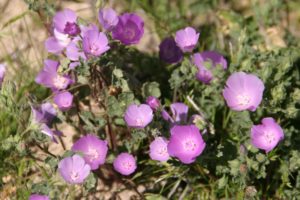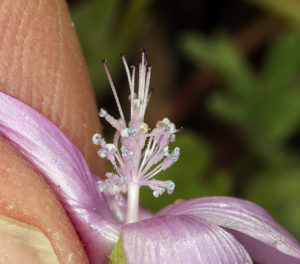Eremalche parryi ssp. kernensis
- Endangered – Endangered Species Act (1990)
- T2 Imperiled – NatureServe (2013)

Kern mallow. Photo by Joe Decruyenaere
Description
The Kern mallow is a plant endemic to California. The plant has white to rose-pink or lavender hollyhock-like flowers with erect stem about two to four inches high. The Kern mallow is an annual herb and normally blooms between March to May. On July 19, 1990, it was officially listed under the Endangered Species Act as an endangered species.
Habitat
The Kern mallow is only found in California and grows on eroded hillsides and alkali flats in non-wetlands under natural conditions at elevations of 200-5000 feet. Vegetation types of its habitat include Chenopod scrub, Shadscale Scrub, valley and foothill grassland. The Kern mallow is often found growing under and around Atriplex spinifera (spiny saltbush), and A. polycarpa (common saltbush) or Ephedra californica (desert tea); at higher elevations (up to 1524 meters or 5000 feet), Kern mallow grows at the base of Juniperus californicus (California juniper) in the juniper scrub community. Kern mallow typically grows in areas where shrub cover is less than 25 percent and average herbaceous cover ranges from 48 to 80 percent. As with many arid-land annuals, the density, phenology (i.e., timing of different stages in the life cycle), reproduction, and population size can vary greatly depending on rainfall.
Distribution
In 1997, the Kern mallow was known from fewer than twenty occurrences, solely in Kern County. Now it is seen in the southernmost inner South Coast Ranges and the southern San Joaquin Valley in Kern, Santa Barbara, San Luis Obispo, and Ventura counties. There have been multiple observations of the Kern mallow in the Los Padres National Forest and the Carrizo Plain National Monument.
Threats

Flower petals of the Kern mallow being held back to expose its inner anatomy. As depicted here, the flower itself is approximately the size of a thumb. Photo by Steve Matson
Since 1990, threats to the Kern mallow have included destruction and adverse modification of habitat due to agricultural land conversion, water development and exploration, exotic plant competition, off-road vehicle use, oil and gas exploration and development, maintenance and expansion of existing transmission corridors, installation of telecommunication and electrical line construction, mineral extraction, and livestock grazing. New threats in Kern mallow habitat include construction of high speed rail, and the construction and operation of solar facilities.
The severity and magnitude of each of these threats is difficult to assess. Of 212 known records, about 59 percent are located on federal lands subject to grazing, off-highway vehicles or other uses; 35 percent are located on private land or land where the ownership status was not known, and only 2 percent were protected on state-owned preserves. Conversion to agriculture (including grazing) and urbanization near the time of listing were a substantial threat on privately-owned lands. Occurrences on public lands may still be subject to other threats including oil and gas exploration and conveyance, solar power developments, off-road vehicle use and mineral exploration and extraction. Road corridors with or without transmission lines reduce the overall survival rate of Kern mallow in the Lokern area (in western Kern County) where the plant was most often found.
Conservation Efforts
The Kern mallow was listed as a federally endangered species in 1990. However, there has been no designation of critical habitat yet but five habitat conservation plans.
Since being listed in 1990, FWS has funded two studies of the Kern mallow and found that its range may be even smaller than previously believed. A long-term study since 2001 by the Center for Natural Lands Management who manages the Lokern Preserve in Kern County has found that drought cycles may be more important than the presence of non-native vegetation in some circumstances.
The Santa Barbara Botanic Garden (SBBG) is a member of the Center for Plant Conservation, and maintains an active conservation collection of seeds held for research and recovery purposes. In 2010 the SBBG became involved in a cooperative project with the Bureau of Land Management (BLM) to secure seed collections of sensitive species from BLM lands, and has collected Kern mallow seeds from several sites on the Carrizo Plain National Monument.
ForestWatch continues to monitor the recovery of the Kern mallow. For several years, we have been working as a part of a coalition to pass the Central Coast Wild Heritage Act which would establish additions to many of the existing wilderness areas in the Los Padres National Forest. One of the proposed Chumash Wilderness additions in Ventura County would be located in the eastern part of the Cuyama River Valley of Ventura County. The Kern mallow is suspected to grow in this area, which will see enhanced protection once it becomes part of the Chumash Wilderness. We also plan to conduct surveys for the plant in the Cuyama River Valley area of the Los Padres National Forest to better understand where this rare and unique species is growing and direct conservation efforts to protecting it further in those areas.






